
I hit the range with a Watchtower Apache to get a new look at the double-stack 9mm 1911.
If you have been looking for a double-stack 1911 pistol (commonly known as a “2011”), you’ve never had it so good. There was a time when they were “competition guns,” and they were heavily used, requiring them to be routinely overhauled and re-fitted by pistolsmiths. But that use taught the ’smiths and makers many lessons, and we have all benefited from the experience.
Now they are everywhere … and a really good one to lay hands on is the Watchtower Apache.
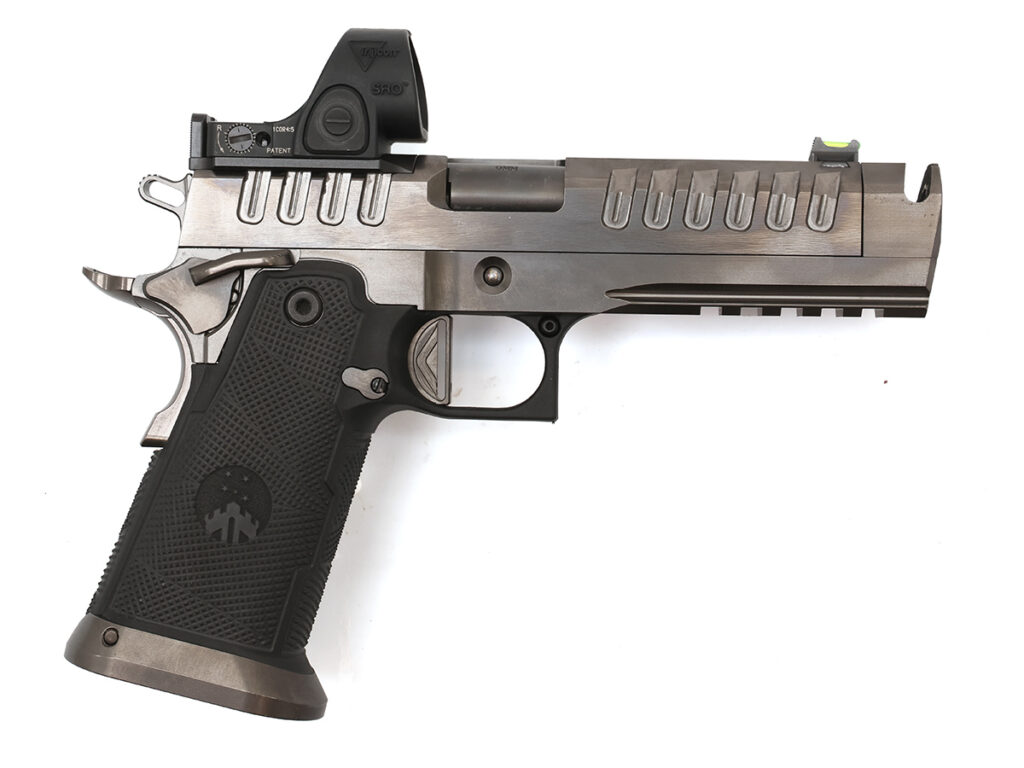
Watchtower Apache Specs
Type: Hammer-fired semi-automatic
Caliber: 9mm
Capacity: 17+1
Barrel: 4.6 inches
Overall Length: 8.6 inches
Height: 5.6 inches
Width: 1.4 inches
Weight: 2 pounds, 9 ounces (with optic)
Finish: PVD, graphite, or graphite w/ copper accents
Grip/Frame: Carbon fiber
Sights: Fixed fiber optic front sight, adjustable rear
Optic Ready: Yes
Trigger: 3 pounds, 7 ounces
MSRP: $4,300 without optic
Contact: WatchtowerFirearms.com, (832) 299-6100
Pros:
- Very reliable
- High capacity
- Good accuracy
Cons:
- Big and heavy for EDC
- Expensive
The overall dimensions of the Apache (named after Operation Apache Snow, aka Hamburger Hill) are the same as a 5-inch government model. Well, a fat one, since there’s a double-stack STI/SVI pattern magazine in there. The magazines the Apache arrives with are a flush-fit 17-round magazine and an extended one holding 20 rounds. They are made by Check-Mate, a company with decades of experience at crafting magazines. In the earliest days, we’d have to fit and tune the magazines ourselves, a process involving rubber mallets and a certain nonchalance about over-tuning. Now, they work 100 percent right out of the box. Again, lessons learned from the forge of competition.

The frame is an assembly, a pre-hardened 4140 machined to be the rails and the holder for the fire control parts. That is married to a composite grip (carbon-fiber reinforced with Kevlar) bolted on as the part that holds the magazine … and the part that you hold on to as well. The grip has a multi-angled set of non-slip traction panels on it, arranged so they work against the movement of recoil. At the bottom is a magwell funnel big enough to be useful but small enough to be concealable if you use the right holster and dress for the occasion.
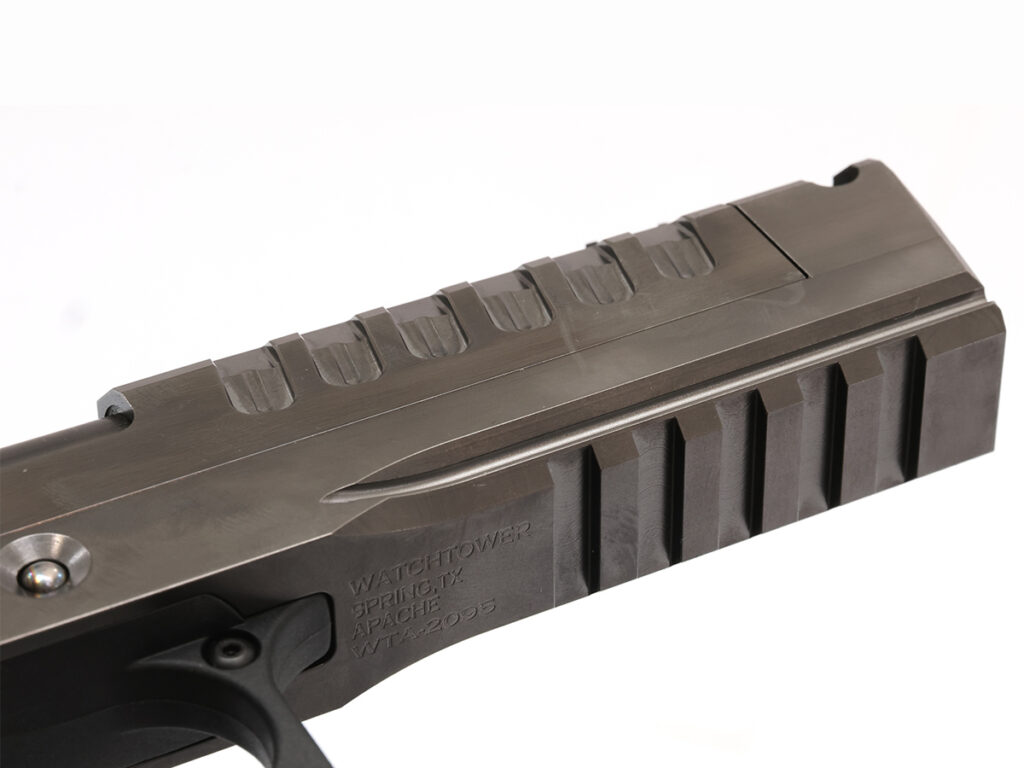
The frame is lifted on the frontstrap, and the beavertail is high, so your hand gets high on the frame. The thumb safety is an ambidextrous, two-paddle affair. They are plenty big, and if you were going to use the Apache as an EDC pistol, you might want to either replace them with some smaller unit or have your pistolsmith shave them down. The trigger is medium length and flat. The steel portion of the frame has an accessory rail that extends all the way to the muzzle for extra weight and complete choice of light or laser mounting.

The slide is aggressively slotted for cocking serrations, and it’s also machined to accept an optic. The one tested came with a Trijicon SRO already installed. The front sight is a fiber optic, and the rear is a notch. The irons are just barely visible in the bottom of the optic viewscreen. The metal components are treated to a PVD coating, making them harder than an auditor’s heart, but easy to clean.
An added detail is the recoil spring guide rod. Most feature a cross-drilled hole, and you need a high-tech bent paperclip to disassemble. The Apache has a tool-less guide rod. With the slide locked back, pinch the rod to angle the capture shoulder out and ease it forward. It’s now locked, and you can disassemble the Apache—a neat detail and easy to use once you get the feel for it.
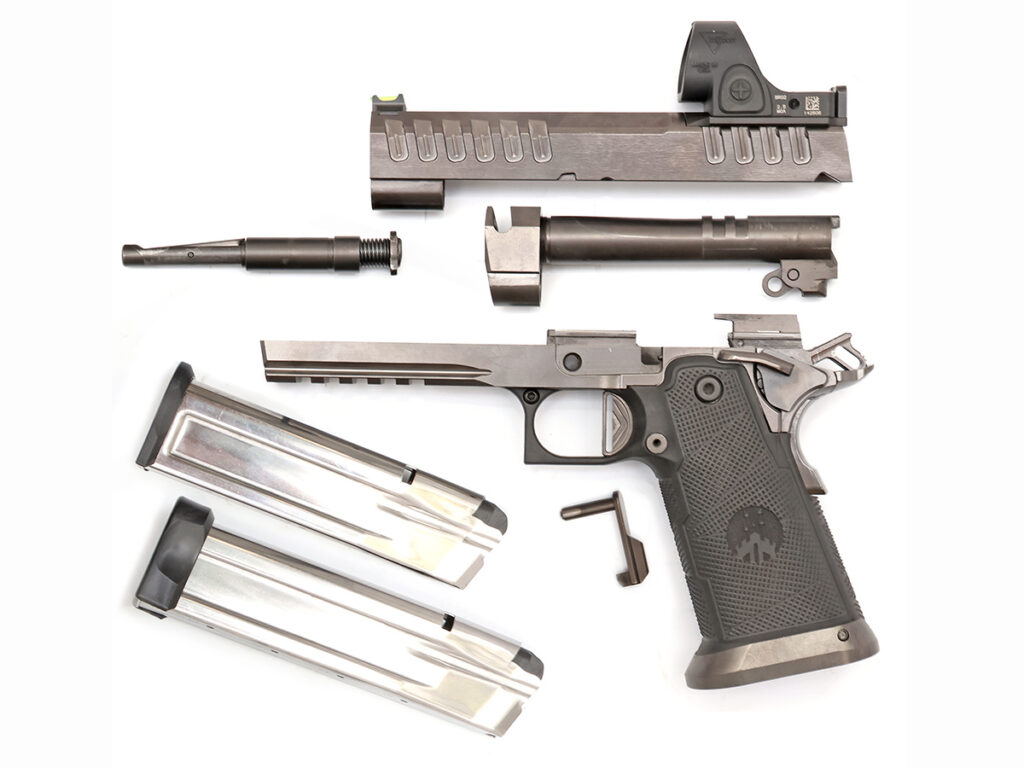
The Apache is the same length as a 5-inch government model, but with a difference. The 416 stainless barrel is just over 4½ inches long and has a Clark/Para dimension integral ramp at the chamber. Forward of the muzzle, Watchtower installs a single-port compensator. Comps are the hot new carry item, but they have been in competition use since the mid 1980s.
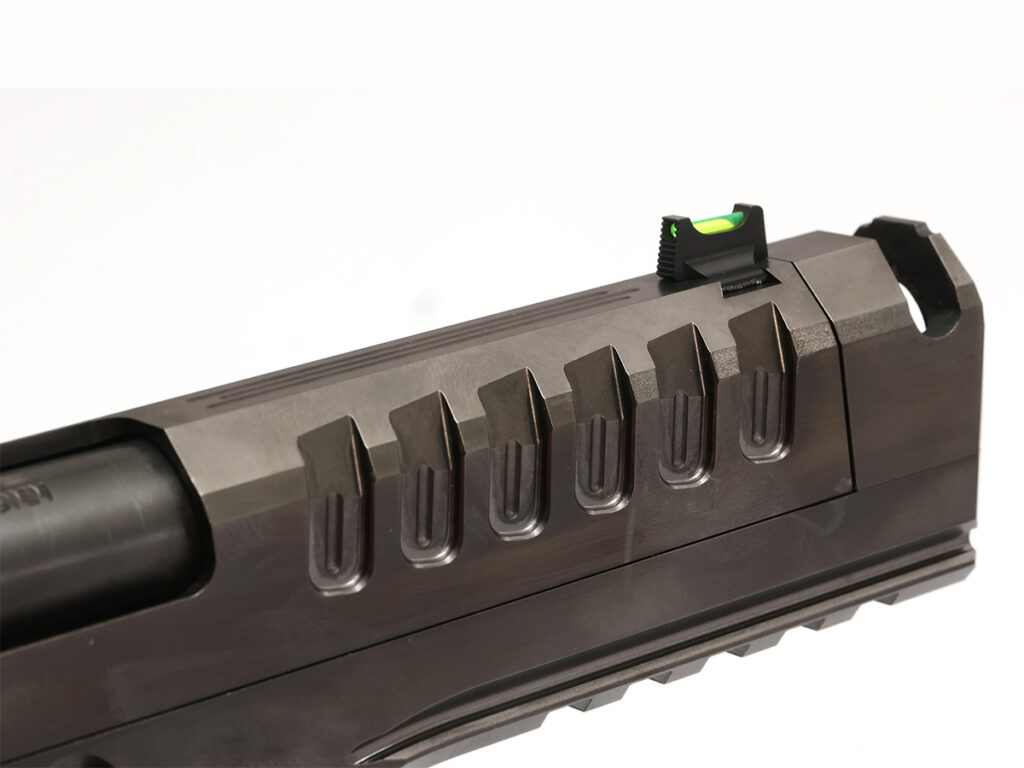
One detail to be aware of is how a comp works. Basically, it’s rocket science. You’re taking some of the gases exiting the muzzle and, by changing their direction, using that energy to change the feel of recoil. The more gases, and the higher pressure they are at, the more energy. The best angles and sizes have been worked out since the mid 1980s, so what you have to know is this: lighter bullets. Lighter bullets, generating any given power factor, require more powder and generate higher pressures than heavy bullets do. That’s why the IPSC world switched from .45 ACP to .38 Super back in the 1980s. So, if you want to get the most benefit from a comp, you run the hottest 115- or 124-grain loads you can lay hands on (or reload, within limits, of course).
But Can She Run?
As a semi-custom pistol (custom features but built as a regular-production inventory item), you’d expect a pistol like the Apache to be accurate and reliable. And you’d be correct in that assumption. I tried the Apache with a variety of ammunition, both competition and daily carry, and it produced groups that were most gratifying. Reliability was 100 percent to the point of being boring in its routine nature. Load magazine, hose down plate rack, reload, repeat.

As the Apache was the perfect description of the best tool for a particular event at The Pin Shoot, I then tested it with some top-end heavy bullet 9mm loads, found what it liked best and took it north to Central Lake to slay pins. I did my best in the Space Gun event. The load it favored was Michigan Ammo 147-grain JRN, and when I did my part, it shoved off the table with enthusiasm.
Alas, I was not as up to the task as the Apache was, and I finished just out of the standings for the prize table. What are the equipment rules there, you ask? For Space Gun, comps and optics are allowed, and there’s no weight limit. That means the 40-plus ounces of the Apache are there to dampen the recoil of 9mm+P equivalent loads.
If comps work best with light bullets, why did I opt for 147-grain bullets for pins? Because 115s and 124s max out in pressure before getting to the upper level of what is needed for pin-whacking efficiency. Next year I’m going to up those even more, putting 147s downrange at just over 1,000 fps. The Apache is more than up to that task.
Chronograph & Accuracy Data
| Ammo | Bullet Weight | Velocity | ES | SD | Accuracy Average (in.) | Accuracy Best (in.) |
| Black Hills Honey Badger | 100 | 1,273 | 52 | 23.4 | 1.4 | 1.3 |
| Sig FMJ | 115 | 1,254 | 12 | 5.3 | 1.5 | 1.4 |
| Super Vel +P JHP | 115 | 1,308 | 37 | 14.2 | 1.3 | 1.1 |
| Fiocchi FMJ | 115 | 1,085 | 72 | 31.9 | 1.6 | 1.4 |
| CorBon JHP | 124 | 1,060 | 58 | 22.8 | 1.5 | 1.3 |
| Michigan Ammo FMJ | 147 | 935 | 53 | 24.9 | 1.4 | 1.2 |
Quality and performance like this does not come cheap. The base Apache is $4,299, and adding an optic puts the price higher. You don’t have to get the Trijicon SRO; you can order the standard Apache and then mount the red-dot optic that makes your heart go pitter-pat. Add some magazines and you are ready for competition, daily carry or both.
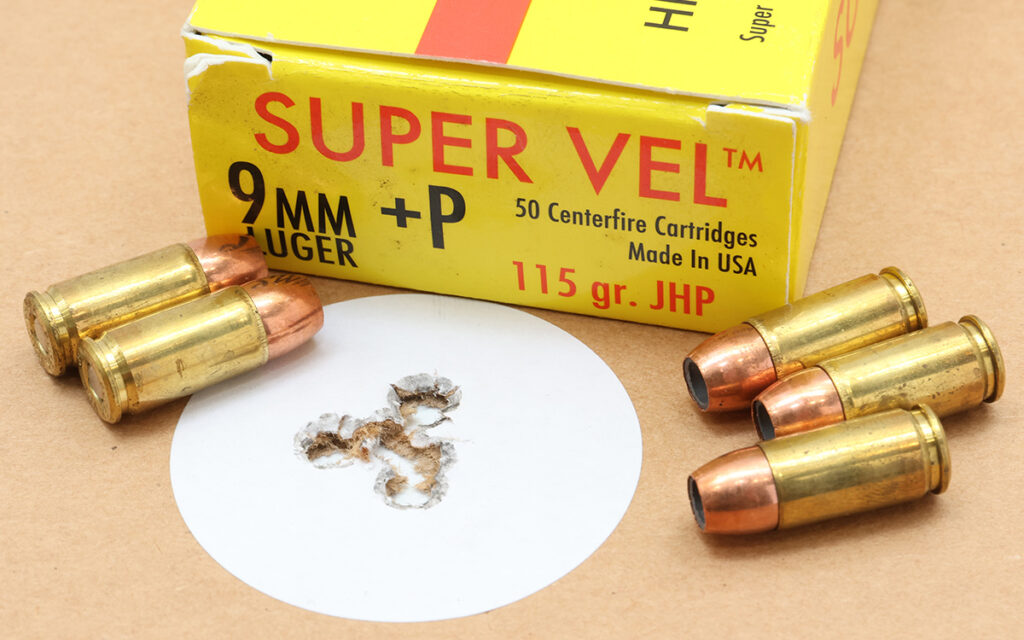
Side Note: What Is This Financial Thing?
You might have read about Watchtower being in some kind of financial trouble lately. So, here’s the inside scoop.
The original company was F-1 Firearms. Current owner and CEO Jason Colosky put together a group to buy F-1 and renamed it Watchtower after Operation Watchtower, the battle for Guadalcanal. As a second-generation Recon Marine, Colosky is well-read on military history (and other history as well) and names his product lines after military operations where he can.
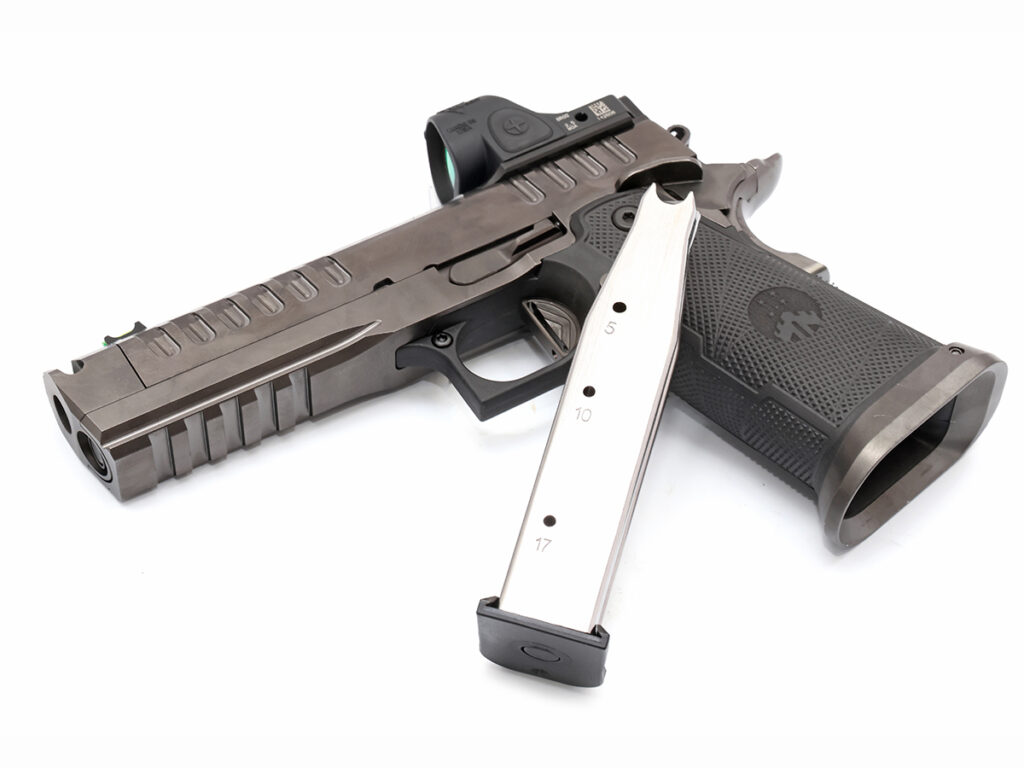
OK, now the financial stuff. Your doom-and-gloom shooting buddy at the gun club might not know the difference between Chapter 11 and Chapter 7. Chapter 7 is the “We’re all gonna die” bankruptcy where the people who are owed money get to divvy up the company because there’s no future for it. Chapter 11 is more like “The economy just threw us a curve, and we need to catch our breath.” Rather than standing by while those owed sort out who gets what, the company gets time to square things away, arrange cash flow and streamline operations. This is all in a plan worked out by the company, its creditors and the court.
In a “7,” if anyone at the company so much as sells a company-owned paperclip before the creditors show up they can go to jail. In an “11” the idea is to encourage moving inventory. The company isn’t going under, they just need elbow room to straighten out some problems.
So, Watchtower and Colosky have been working hard to satisfy everyone. The factory in Spring, Texas, is working near or at capacity, and orders are being filled as quickly as products can be shipped. Everyone is getting paid (employees, creditors, the bank, suppliers, the IRS), and once the contractual agreement has been met (that’s what Chapter 11 is, by the way, a contract), Watchtower will have put the problems behind them.
In the meantime, first-class firearms like the Apache will keep heading out the door to eager customers.
Once it is over we can look forward to more excellent product offerings.
Editor's Note: This article originally appeared in the October 2025 issue of Gun Digest the Magazine.
More On 2011s:
- On The Range With The Springfield Prodigy DS Commander
- Two Turkish 2011s: Tisas B9R Carry Vs. MAC 1911 DS
- Prodigious Pistola: Springfield Prodigy DS Full-Size Review
- The Oracle Arms 2311
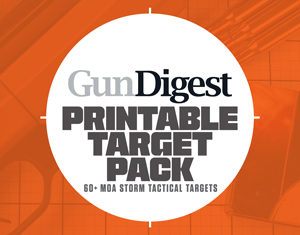
Next Step: Get your FREE Printable Target Pack
Enhance your shooting precision with our 62 MOA Targets, perfect for rifles and handguns. Crafted in collaboration with Storm Tactical for accuracy and versatility.
Subscribe to the Gun Digest email newsletter and get your downloadable target pack sent straight to your inbox. Stay updated with the latest firearms info in the industry.

![Best Concealed Carry Guns In 2025 [Field Tested] Wilson Combat EDC X9S 1](https://gundigest.com/wp-content/uploads/Wilson-Combat-EDC-X9S-1-324x160.jpg)


![Best 9mm Carbine: Affordable PCCs [Tested] Ruger Carbine Shooting](https://gundigest.com/wp-content/uploads/Ruger-Carbine-Shooting-100x70.jpg)
![Best AR-15: Top Options Available Today [Field Tested] Harrington and Richardson PSA XM177E2 feature](https://gundigest.com/wp-content/uploads/Harrington-and-Richardson-PSA-XM177E2-feature-100x70.jpg)

Too bad it’s chambered for a round that has proven to be a lousy
Man stopper in real combat.
A .45 acp please.